Nov 03, 2021
Interesting read…
https://www.autoblog.com/2021/11/03/ford-bronco-suspension-deep-dive/
Ford Bronco Suspension Deep Dive | 35-inch reasons to avoid Sasquatch
We take off those 35-inch tires for an in-depth look at the ultimate Bronco's suspension
DAN EDMUNDS
Nov 3rd 2021 at 7:00AM
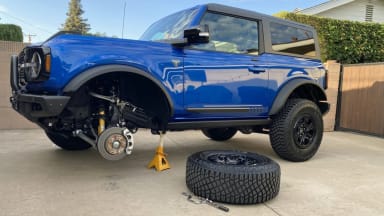
It has been over a year since I pieced together a Ford Bronco speculative suspension deep diveusing preliminary specifications, comparisons to the overseas-market Ranger Raptor, and teaser photos of a naked chassis. Today the specs are more complete, and I’ve been able to lay my hands on the real thing for a closer look in my own driveway. The two-door body may be bolted in place this time, but I’ll take that because I’m able to remove the tires and poke around underneath.
This Bronco is a two-door First Edition, a 2021 trim level that's sold out. You can basically ignore that fact, because everything it included can be still found on the 2022 Ford Bronco Badlands. Importantly, it also has everything we’d care to look at as far as a suspension deep dive is concerned, plus more. It had the stabilizer bar disconnect mechanism shared with the Badlands, locking front and rear differentials that are common to the Badlands and the Wildtrak, and the Sasquatch combination of HOSS Bilstein dampers and 35-inch tires that comes standard on Wildtrak and can be added to any trim as an option.
The Bronco I prefer is the Badlands, which has everything we’ll see here, but with 33-inch tires paired with a longer-travel set of HOSS Bilstein dampers. The reason? The 33s don’t stuff the wheel wells as much as this 35-inch rubber, and as a result, they allow for greater flex and articulation. This setup, with the 35s, managed a 648-point maximum Flex Index score on my RTI ramp (see video above), but a Badlands withoutSasquatch would do even better.
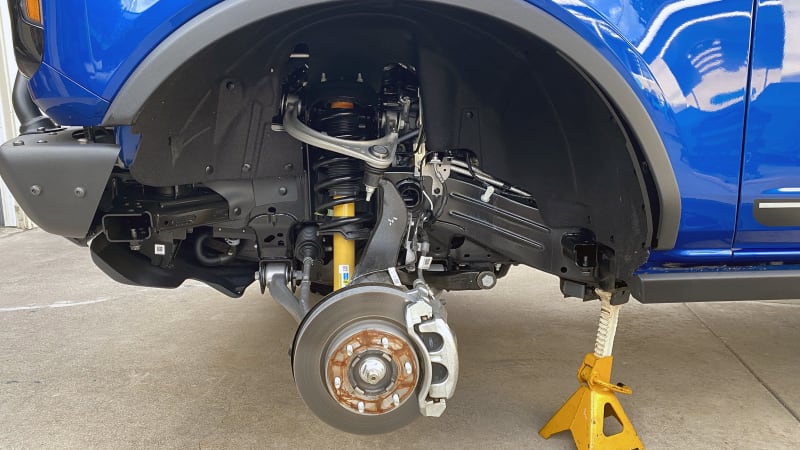
Most of the Bronco vs Wrangler trash talk centers on the Bronco’s use of independent front suspension. Jeep people will say, “Solid front axles flex more.” They’re not wrong, but solid axles don’t ride smoothly or steer accurately when you’re not off-roading, and they’re not nearly as settled on washboard dirt roads. Unless the need for maximum articulation enters the frame, independent front suspension and the lower unsprung mass that comes with it can be a better way to go if that suspension offers decent ground clearance and a healthy amount of travel.
The suspension we see here is not a direct carryover from the North American Ford Rangerpickup we know. Instead it comes from the Ranger Raptor sold in Australia, Europe and other parts of the world. As the Raptor name implies, it’s a wide-track, long-travel independent front suspension. Rumors of a U.S. Bronco Raptor will no doubt build up from what we’ll see here.

It’s clearly a double wishbone front suspension, with upper (yellow) and lower (green) wishbones made of aluminum, and a steering knuckle (red) that’s made of steel. This combination is a direct opposite of the North American Ranger pickup, which uses steel arms and an aluminum knuckle.
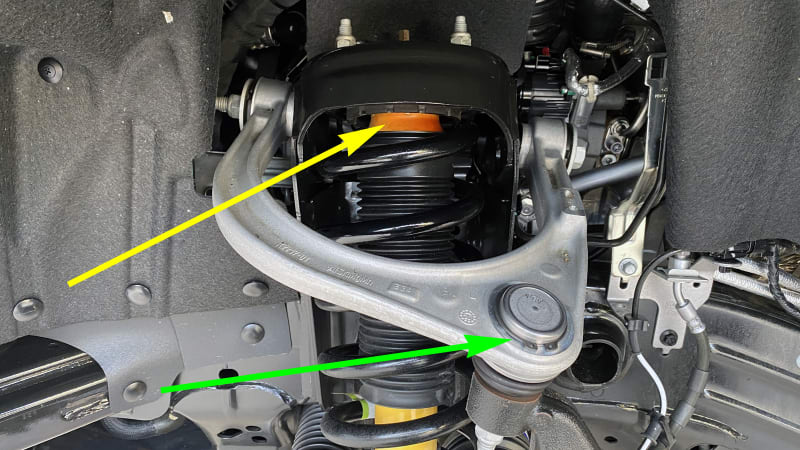
The front bump stop (yellow) is a urethane bumper that sits at the top end of the coil-over spring and damper assembly. Ford uses this design instead of the frame-mounted bump-stops we’re used to seeing on a Tacoma or 4Runner because it gives them greater freedom to tweak the available suspension travel using bolt-on parts.
The aluminum upper control arm (green) is canted downward toward the back to generate a helpful dose of anti-dive geometry, and the ball joint is set far back to help generate a healthy dose of caster. Beyond that, the ball-joint seems to be held in place with a circlip that should allow for easy changes or aftermarket upgrades.
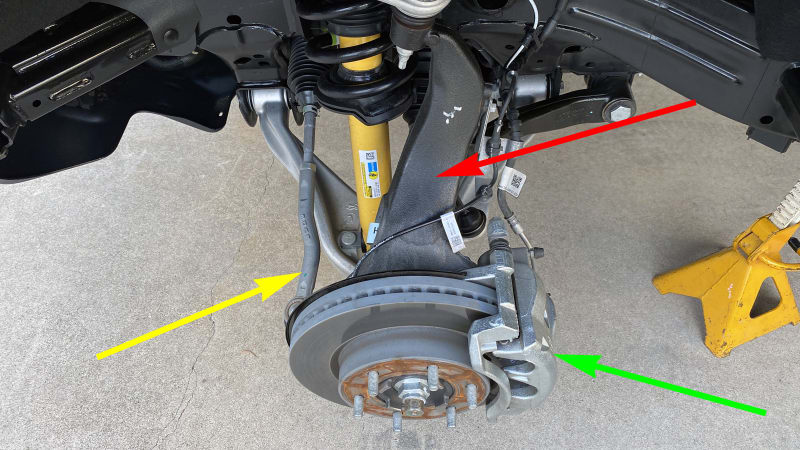
When in place, the tire barely hides the upper ball joint that’s just peeking into this picture. We’re not seeing the extreme high-mount design favored by Toyota, but the front knuckle (red) is still quite tall, a move that reduces upper ball-joint and wishbone bushing loads by increasing the vertical separation distance from the tire contact patch at the ground.
This view also makes it clear that the Bronco has the kind of front-steer rack placement (yellow) we expect to see when an engine is mounted lengthwise, and why the space occupied by the rack-and-pinion steering linkage forces the brakecaliper (green) to occupy the unused space on the opposite side.

You may have wondered how heavy that steel knuckle (yellow) was going to be, but it’s actually hollow. We’re also getting our first glimpse of how the Bilstein HOSS dampers bolt to the lower wishbone via a lower bushing (green) with a molded-in tie-bar. These dampers have piggyback remote reservoirs (red), and if we could peer inside we’d see stiffer end-travel damping zones at the extreme top and bottom ends of the shock to guard against topping and bottoming.

The lower wishbone and knuckle have protuberances (yellow) that work together as a steering limit stop to keep the steering rack from loading up against its internal end-stop. The other thing to notice is how the knuckle’s thickness is locally optimized (green) to save further weight beyond what they’ve achieved by making the upper section hollow.
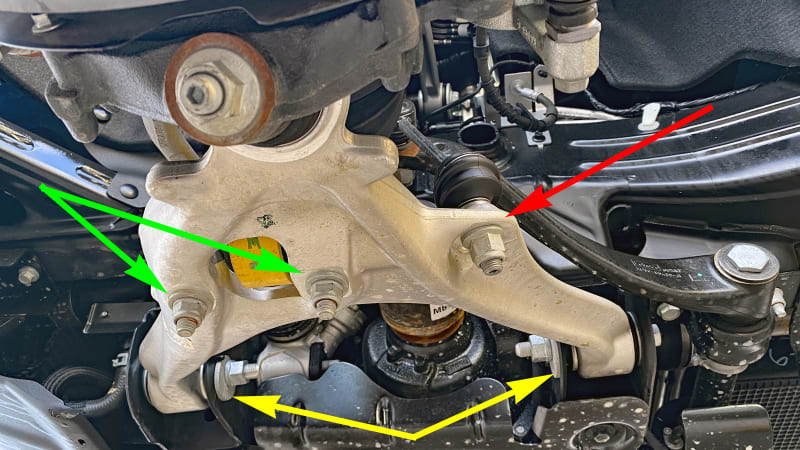
Each leg of the wishbone has eccentric cams (yellow) that allow for caster and camber adjustment, and further out we can see the nuts (green) that hold the damper in place. Meanwhile, the stabilizer bar end-link (red) connects to the rear leg of the wishbone.
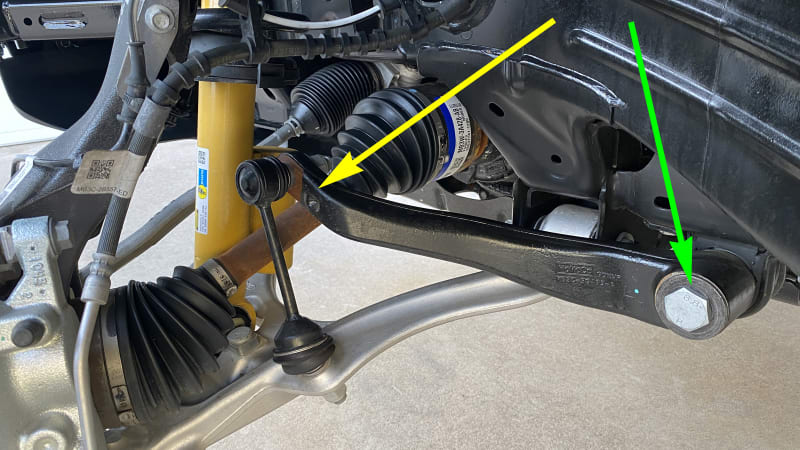
The stabilizer linkage connects to a weird-looking stabilizer bar arm (yellow). We’re used to seeing stabilizer bars made from a simple bent piece of round-stock, but this one consists of a blade that’s bolted (green) and indexed to a separate crosspiece, as you might see in a racecar.
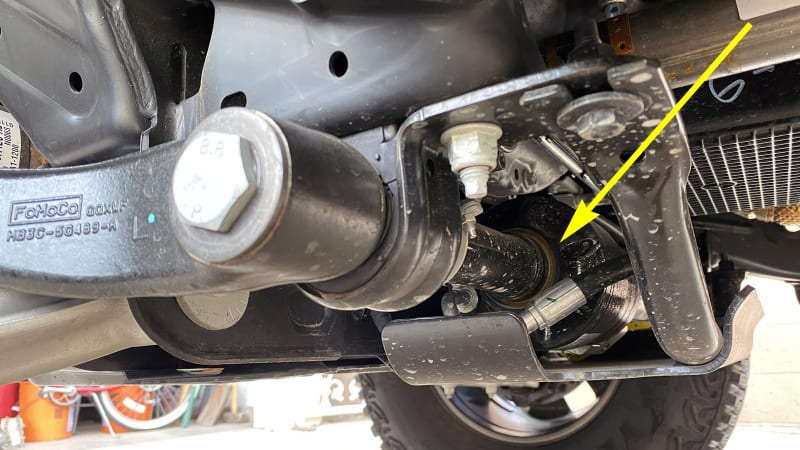
https://www.autoblog.com/2021/11/03/ford-bronco-suspension-deep-dive/
Ford Bronco Suspension Deep Dive | 35-inch reasons to avoid Sasquatch
We take off those 35-inch tires for an in-depth look at the ultimate Bronco's suspension
DAN EDMUNDS
Nov 3rd 2021 at 7:00AM
- 3comments

It has been over a year since I pieced together a Ford Bronco speculative suspension deep diveusing preliminary specifications, comparisons to the overseas-market Ranger Raptor, and teaser photos of a naked chassis. Today the specs are more complete, and I’ve been able to lay my hands on the real thing for a closer look in my own driveway. The two-door body may be bolted in place this time, but I’ll take that because I’m able to remove the tires and poke around underneath.
This Bronco is a two-door First Edition, a 2021 trim level that's sold out. You can basically ignore that fact, because everything it included can be still found on the 2022 Ford Bronco Badlands. Importantly, it also has everything we’d care to look at as far as a suspension deep dive is concerned, plus more. It had the stabilizer bar disconnect mechanism shared with the Badlands, locking front and rear differentials that are common to the Badlands and the Wildtrak, and the Sasquatch combination of HOSS Bilstein dampers and 35-inch tires that comes standard on Wildtrak and can be added to any trim as an option.
The Bronco I prefer is the Badlands, which has everything we’ll see here, but with 33-inch tires paired with a longer-travel set of HOSS Bilstein dampers. The reason? The 33s don’t stuff the wheel wells as much as this 35-inch rubber, and as a result, they allow for greater flex and articulation. This setup, with the 35s, managed a 648-point maximum Flex Index score on my RTI ramp (see video above), but a Badlands withoutSasquatch would do even better.

Most of the Bronco vs Wrangler trash talk centers on the Bronco’s use of independent front suspension. Jeep people will say, “Solid front axles flex more.” They’re not wrong, but solid axles don’t ride smoothly or steer accurately when you’re not off-roading, and they’re not nearly as settled on washboard dirt roads. Unless the need for maximum articulation enters the frame, independent front suspension and the lower unsprung mass that comes with it can be a better way to go if that suspension offers decent ground clearance and a healthy amount of travel.
The suspension we see here is not a direct carryover from the North American Ford Rangerpickup we know. Instead it comes from the Ranger Raptor sold in Australia, Europe and other parts of the world. As the Raptor name implies, it’s a wide-track, long-travel independent front suspension. Rumors of a U.S. Bronco Raptor will no doubt build up from what we’ll see here.

It’s clearly a double wishbone front suspension, with upper (yellow) and lower (green) wishbones made of aluminum, and a steering knuckle (red) that’s made of steel. This combination is a direct opposite of the North American Ranger pickup, which uses steel arms and an aluminum knuckle.

The front bump stop (yellow) is a urethane bumper that sits at the top end of the coil-over spring and damper assembly. Ford uses this design instead of the frame-mounted bump-stops we’re used to seeing on a Tacoma or 4Runner because it gives them greater freedom to tweak the available suspension travel using bolt-on parts.
The aluminum upper control arm (green) is canted downward toward the back to generate a helpful dose of anti-dive geometry, and the ball joint is set far back to help generate a healthy dose of caster. Beyond that, the ball-joint seems to be held in place with a circlip that should allow for easy changes or aftermarket upgrades.

When in place, the tire barely hides the upper ball joint that’s just peeking into this picture. We’re not seeing the extreme high-mount design favored by Toyota, but the front knuckle (red) is still quite tall, a move that reduces upper ball-joint and wishbone bushing loads by increasing the vertical separation distance from the tire contact patch at the ground.
This view also makes it clear that the Bronco has the kind of front-steer rack placement (yellow) we expect to see when an engine is mounted lengthwise, and why the space occupied by the rack-and-pinion steering linkage forces the brakecaliper (green) to occupy the unused space on the opposite side.

You may have wondered how heavy that steel knuckle (yellow) was going to be, but it’s actually hollow. We’re also getting our first glimpse of how the Bilstein HOSS dampers bolt to the lower wishbone via a lower bushing (green) with a molded-in tie-bar. These dampers have piggyback remote reservoirs (red), and if we could peer inside we’d see stiffer end-travel damping zones at the extreme top and bottom ends of the shock to guard against topping and bottoming.

The lower wishbone and knuckle have protuberances (yellow) that work together as a steering limit stop to keep the steering rack from loading up against its internal end-stop. The other thing to notice is how the knuckle’s thickness is locally optimized (green) to save further weight beyond what they’ve achieved by making the upper section hollow.

Each leg of the wishbone has eccentric cams (yellow) that allow for caster and camber adjustment, and further out we can see the nuts (green) that hold the damper in place. Meanwhile, the stabilizer bar end-link (red) connects to the rear leg of the wishbone.

The stabilizer linkage connects to a weird-looking stabilizer bar arm (yellow). We’re used to seeing stabilizer bars made from a simple bent piece of round-stock, but this one consists of a blade that’s bolted (green) and indexed to a separate crosspiece, as you might see in a racecar.

- 2023 Raptor / Shadow Black / MGV (DOB 8/30/23)
- 2023 Heritage Limited Edition / Robin’s Egg Blue / 4dr / (stolen from my dealer 11/15/23)
- 2023 Heritage Limited Edition / Robin’s Egg Blue / 4dr / (stolen from my dealer 11/15/23)
jd-ford-hd, Bronc96
Last edited by a moderator:
Nov 03, 2021